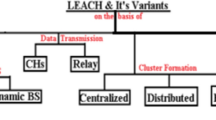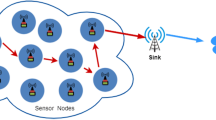Abstract
In recent years, mobile relay has been studied in order to reduce the energy consumption in WSN El-Moukaddem et al. (Mobile Relay Configuration in Data-intensive Wireless Sensor Networks, 2009). The concept of mobile relay is that some movable nodes change their location so as to minimize the total energy consumed by both wireless transmission and locomotion. Mobile relay needs to determine an initial route that represents the sequence of relaying nodes. We have already proposed several initial route construction algorithms based on greedy approaches Shigei et al. (IAENG Int J Comput Sci 39: 321–328, 2012), Yudo et al. (Battery-Aware Initial Route Construction for Mobile Relay on Wireless Sensor Network, 2012). However, the conventional method cannot always provide optimal routes, because they do not examine all the possible routes. In this paper, we propose a battery-aware initial route construction method based on Dijkstra’s algorithm (BAIR-D), which utilizes the node information outside of the direct communication range. The algorithm has a capability to examine all the possible routes. We show the effectiveness by numerical simulation.






Similar content being viewed by others
Notes
MANET (Mobile Ad hoc Network) also consists of the mobile nodes. However, MANET is different from MWSN. For MANET, the mobile nodes are free to move independently in any directions. On the other hand, for MWSN, sensor nodes do not move around independently but move for improving the communication efficiency instead.
References
Yick J et al (2008) Wireless sensor network survey. Comput Netw 52:2292–2330
El-Moukaddem F et al (2009) Mobile Relay Configuration in Data-intensive Wireless Sensor Networks. In: Proceedings of International Conference on Mobile Adhoc and Sensor Systems, pp 80–89
El-Moukaddem F et al (2010) Maximing Data Gathering Capacity of Wireless Sensor Networks using Mobile Relays. In: Proceedings of International Conference on Mobile Adhoc and Sensor Systems, pp 312–321
Shigei N et al (2012) Battery-aware algorithms for mobile relay and route construction on wireless sensor network. IAENG Int J Comput Sci 39(3):321–328
Yudo YAS et al (2012) Battery-Aware Initial Route Construction for Mobile Relay on Wireless Sensor Network. In: Joint Conference of the Kyushu Branch of the Institute of Electrical and Electronics Engineering, International Session, p 164
Sniedovich M (2006) Dijkstra’s algorithm revisited: the dynamic programming connecxion. Control Cybern 35(3):600–619
Pushpalata N et al (2012) Shortest path position estimation between source and destination nodes in wireless sensor networks with low cost. Int J Emerg Technol Adv Eng 2:6–12
Ambreen, Nawaz H (2013) Wireless sensor network through shortest path route. Int J Emerg Technol Adv Eng 3:158–161
Wang G et al (2005) Optimizing sensor movement planning for energy efficiency. In: ISLPED, pp 215–220
Sha M et al (2009) C-mac: Model-driven concurrent medium access control for wireless sensor networks. In: INFOCOM
Acknowledgments
This work was supported by JSPS KAKENHI Grant Number 26330108.
Author information
Authors and Affiliations
Corresponding author
About this article
Cite this article
Yudo, Y.A.S., Shigei, N. & Miyajima, H. Effective initial route construction for mobile relay on wireless sensor network. Artif Life Robotics 20, 49–55 (2015). https://doi.org/10.1007/s10015-014-0194-5
Received:
Accepted:
Published:
Issue Date:
DOI: https://doi.org/10.1007/s10015-014-0194-5




